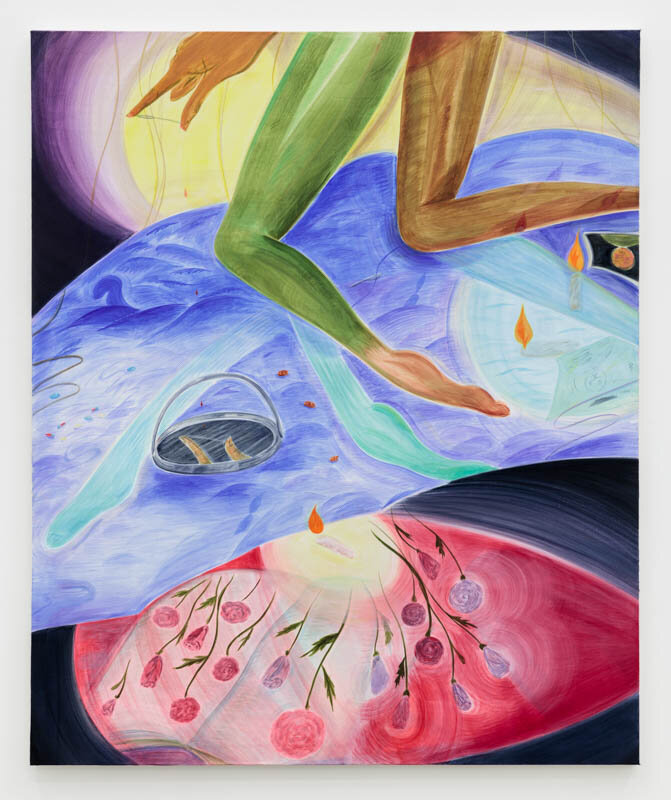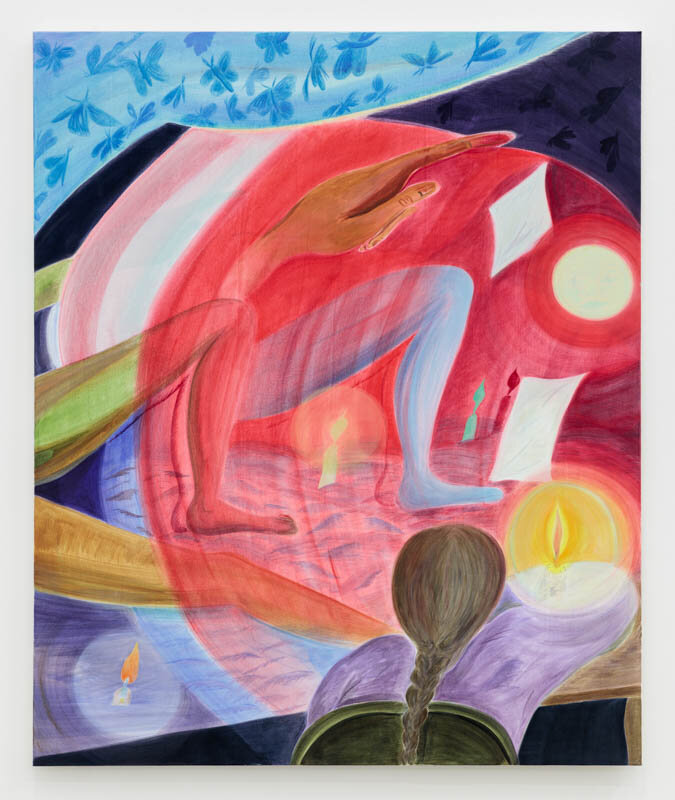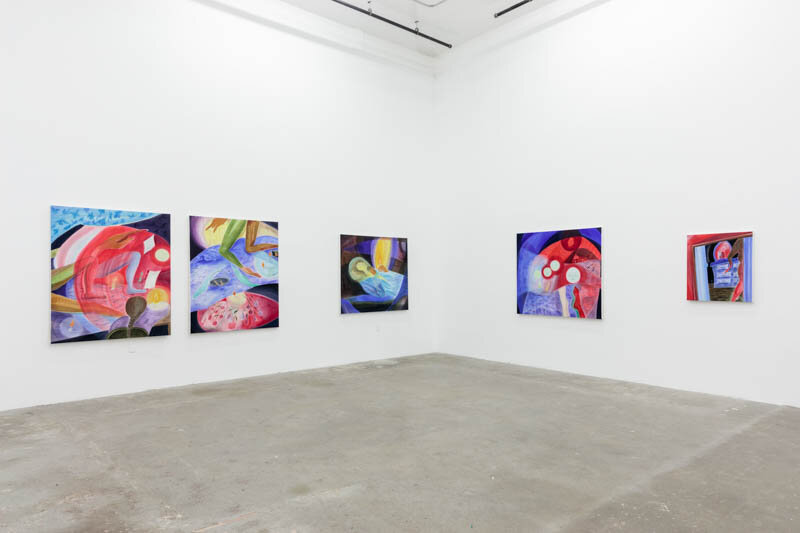Anjuli Rathod
Anjuli Rathod lives and works in Queens, New York. She attended the School of the Museum of Fine Arts, Boston. She has participated in residencies at The Millay Colony of the Arts, the Studios at MASS MoCA, and the Shandaken Project. Recent exhibitions include a solo show at Interstate Projects, Brooklyn, two-person shows at Projet Pangeé, QC and Safe Gallery, NY, and group shows at Tiger Strikes Asteroid, NY; Selenas Mountain, Brooklyn, and Knockdown Center, Queens.
Statement
I use painting to form overarching narratives that reflect states of anxiety, alienation, and self-examination. As figures meld into and emerge out of their environments, objects and animals stand in as proxies for psychological states, which serve as descriptors when language falls short of describing experience and memory. I am interested in how this especially reflects diasporic identities, which I describe with elliptic images and animism of space, due to a lack of precise language. I seek to understand this kind of unknowing via these narratives’ lack of conclusion and undercurrent of violence, and to explore cycles and dualities between dream and reality, life and death, liquidity and solidity. I begin my process making drawings that cull from my life and various outside sources. In my most recent work, I have been interested I have been interested in the idea of living in mourning whether in a personal and more global sense, and how this reflects relationships between personal ritual, solitude, and alchemical transformation.
Burial, acrylic and flashe on canvas, 48x54 inches, 2019
Interview with Anjuli Rathod
Questions by Emily Burns
Hi Anjuli! Can you tell us a bit about your background and how you decided to pursue a path as an artist? Do you have any early creative memories? Are any family members artists?
Hi Emily! I grew up in a suburb outside of Philadelphia. No one in my family are artists. Probably because I spent a lot of time alone I was always drawing, making books, reading, and watching a lot of television and movies. I think as a kid I felt like art, particularly drawing, was something that was just for me. It was a way to express feelings and process memories without judgement. My art teacher in high school encouraged me to apply to art school.
Your paintings are figurative, but loosely rendered in acrylic and Flashe. Have you always worked in the way you work now?
I painted throughout most of college working in between figuration and abstraction. After I moved to New York I made mostly drawings and watercolors for a few years, essentially detailed psychological renderings of my messy and chaotic apartment. After I started painting again a few years ago the way I’ve worked has kept changing over time.
Can you take us through the process of making a painting? How do you begin?
I keep little notes of words, ideas, phrases, and images on my phone or in notebooks. I’m pretty much always drawing. The drawings that get used for paintings are usually pen or pencil on basic drawing paper, and are more like sketches, so that there’s room for change—sometimes it’s more than one that I’ll pair together to figure out later on the canvas. Then I’ll render that drawing onto the canvas with a pale colored paint as an outline. The paintings are built up over washes, like watercolor, except that I can paint over areas when I want to. I tend to work pretty slowly and usually take a lot of breaks to step back from the paintings to keep from overworking them, and often make new drawings of the painting as it evolves.
Sleep shapes, acrylic and flashe on canvas, 48x54 inches, 2019
Red and blue seem to appear together often in your work. Does that color combination stem from any particular reference?
I think I’m drawn to how red and blue feel elemental and dramatic, dreamy and hallucinogenic. A few years ago I read “Bluets” by Maggie Nelson. I wanted to follow that study on blue and found “On Being Blue” by William H. Gass which is different in structure and tone but explores the color as well. It felt natural to explore red after those... “Incubation: a Space For Monsters” by Bhanu Kapil and “Autobiography of Red” by Anne Carson both have a red skinned protagonist, part monster, partly human. I’m always so inspired by Bhanu Kapil’s writing and how she thinks about diaspora and elliptical narration.
In your statement you describe moments where the work communicates ideas where language falls short—and embodies dualities, including that of dreams and reality. I love that painting often translates deep emotions that are challenging to describe, including this odd sensation of being caught between worlds. You also mention the idea of living in mourning. Can you talk a bit about that feeling, and why you are drawn to exploring this state of being? Is the mourning stemming from particular sources—the state of the environment for example—or many different aspects of human existence? Are they more personal or universal?
I do worry a lot about impending ecological collapse. The scale of this loss feels incomprehensible. I think that makes its way into the paintings in some way, but indirectly. For a long time I’ve been interested in cycles of life and death, rebirth, and living with an absence. Much of this interest stems from personal experience. The imagery I use is both from my life and from outside sources, as well as the Hindu rituals I was raised around that were at times used to remember or honor those who are gone.
My most recent body of work has a loose narrative centering a red girl who is alone on a journey through grief and loneliness. One of the paintings, “Burial”, was in part inspired by the the Kiarostami film “Taste of Cherry” and an episode of “Monk”, a tv show from the early aughts. Monk is a private detective who lost his job as a police officer after his wife is killed and he becomes incredibly neurotic and obsessive compulsive. He’s so over the top and dramatic, which I really like. In one episode he is chasing a suspect who traps him in a coffin with a candle and buries him alive. Monk, who is claustrophobic, lights the candle and starts hallucinating his late wife as the oxygen burns away, and she encourages him to blow out the candle and save himself. After an intense personal loss you begin to imagine an afterlife: ghosts, communion with spirits, parallel worlds, dream worlds.
Book of flowers, acrylic and flashe on canvas, 46x38 inches, 2019
What is a typical day like for you?
I have a full time job working for an artist, so after I’m done there I’ll usually go to the studio. On the weekends I get there sometime in the afternoon. For about an hour I’ll stare at my phone, look at scraps of paper and move things around. Then I’ll stay until I’m ready to go home, however long that is.
Can you tell us about your studio? What do you need to be productive there?
I share a studio with a friend in Brooklyn. I need solitude, walls that go up to the ceiling, and a space I’m settled into. I’m definitely more of a night person—I don’t want to feel connected to the outside world when I’m in the studio.
Do you prefer to be energetic and upbeat or calm and reflective when working? How do you cultivate the mood in the studio?
My paintings are pretty emotional but when I’m painting I don’t really think about anything. I usually listen to a podcast or audiobook. I can’t really listen to most music because it affects my mood too much. Sometimes I listen to something on Radio Garden or nothing at all. I prefer painting in dim or tinted light. There is nothing worse than fluorescent overhead lighting.
You're currently based in Queens. What has your experience of living in the city been like? Is there anything specific about NYC that feeds your practice?
I wanted to move to a city because I hated the place where I grew up—middle class suburban brand of racism, the strip malls, the isolation. New York hasn’t been easy—I’ve been here for ten years. It can be really really demoralizing: the art world, jobs, money, real estate... I’ve been lucky enough to find friends who are open and have integrity. That has been really generative. I’m sure not everyone feels this way, but it’s possible to do your own thing and move at your own pace here- my path at least has been very slow and steady.
Who are some of the artists you look at most often?
I don’t really look at anyone in particular very often but some artists I love are Ana Mendieta, Leonora Carrington and Remedios Varos. The Hilma af Klint exhibition at the Guggenheim was amazing. I’ve enjoyed looking at Indian classical painting for many years, more recently a kind called Nayika paintings.
Is there any advice you have received that you remember often?
I remember an interview with Jesmyn Ward where she recounts the advice that she took during a time when she was struggling in her career, which was to persist and to work on craft rather than build connections. I really believe that motivation has to come within—you can’t expect people to care about or look at your work. Before everything else you just have to do make your art and push yourself.
Whats up next for you?
Making new things!
Thanks so much for taking the time to talk with us!
Thank you, Emily!
To find out more about Anjuli and her work, check out her website.







